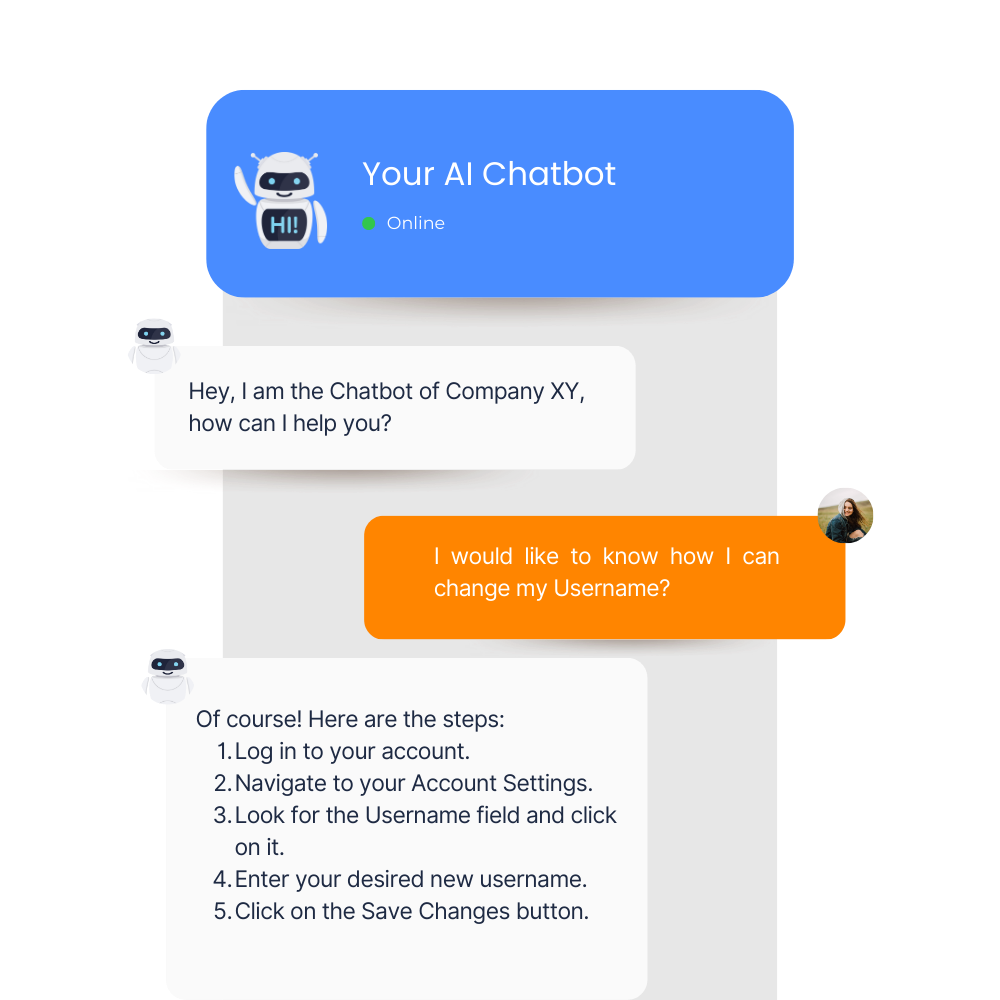Implementing an omnichannel support strategy
An omnichannel support strategy involves providing seamless, consistent, and personalized customer service across multiple channels, such as email, phone, live chat, social media, and more.
Make your whole documentation easily accesable through an easy-to-use chatbot that uses your whole knowledgebase to answer any question your customers might have.

Exploring the benefits of an omnichannel support strategy:
1. Increased customer satisfaction: By offering support through multiple channels, customers can choose the most convenient method to reach out to your business. This flexibility leads to a more positive customer experience and higher satisfaction levels.
2. Improved customer retention: A seamless and consistent support experience across all channels helps build customer trust and loyalty. This, in turn, increases the likelihood of customers returning to your business for future purchases.
3. Enhanced brand reputation: Providing top-notch customer service through an omnichannel support strategy can help elevate your brand’s reputation. Satisfied customers are more likely to recommend your business to others, leading to increased brand awareness and potential new customers.
4. Streamlined support operations: Implementing an omnichannel support strategy enables your support team to manage customer inquiries more efficiently. With a centralized system in place, support agents can easily access customer information and history, leading to faster resolution times and a more organized workflow.
5. Data-driven insights: By collecting data from various customer support channels, businesses can gain valuable insights into customer behavior and preferences. This information can be used to make informed decisions and improvements to your support strategy, ultimately enhancing the overall customer experience.
Incorporating an omnichannel support strategy into your business can bring numerous benefits, from increased customer satisfaction to improved operational efficiency. By leveraging the power of Knowbo’s AI-powered chatbots, your business can take its customer support to new heights, providing an exceptional experience that keeps customers coming back for more.
Utilizing AI-powered chatbots for faster response times
Here are some key benefits of implementing chatbots in your customer support strategy:
1. 24/7 availability: AI-powered chatbots can provide round-the-clock support, ensuring that customers receive assistance whenever they need it. This constant availability helps improve customer satisfaction and builds trust in your brand.
2. Instant responses: Unlike human support agents, chatbots can respond to customer inquiries instantly. This reduces wait times and allows customers to get the answers they need quickly, leading to a more positive customer experience.
3. Efficient handling of repetitive tasks: Chatbots can efficiently handle repetitive tasks, such as answering frequently asked questions or providing basic information about your products or services. This frees up your support agents to focus on more complex issues, increasing overall productivity.
Make your whole documentation easily accesable through an easy-to-use chatbot that uses your whole knowledgebase to answer any question your customers might have.

4. Cost-effective solution: Implementing AI-powered chatbots can help reduce your customer support costs. By automating a portion of your support operations, you can minimize the need for additional human agents, lowering your overall expenses.
5. Personalized support: AI-powered chatbots can be programmed to deliver personalized support based on individual customer preferences and history. This tailored approach helps create a more engaging and satisfying customer experience.
6. Seamless integration with existing systems: Chatbots can be easily integrated into your existing customer support infrastructure, allowing for a smooth transition and minimal disruption to your operations.
By incorporating AI-powered chatbots like Knowbo into your customer support strategy, you can provide faster response times, improve efficiency, and enhance the overall customer experience.
Empowering support agents through proper training and tools
By investing in your support team’s development, you can ensure they have the necessary skills and knowledge to effectively assist your customers.
Here are some ways to enhance your support agents’ skills and capabilities:
1. Comprehensive training programs: Provide your support agents with thorough training on your products, services, and company policies. This will ensure they have a deep understanding of your business and can confidently address customer inquiries.
2. Regular skill development: Continually develop your support agents’ skills through ongoing training, workshops, and seminars. This will help them stay up-to-date with industry trends and best practices, ultimately improving their ability to serve your customers.
3. Access to effective tools: Equip your support agents with the right tools and technology to streamline their workflow and improve efficiency. This may include customer relationship management (CRM) software, helpdesk systems, and AI-powered chatbots like Knowbo.
Make your whole documentation easily accesable through an easy-to-use chatbot that uses your whole knowledgebase to answer any question your customers might have.

4. Collaborative environment: Encourage a collaborative atmosphere within your support team, where agents can easily share knowledge and learn from one another. This can help improve problem-solving skills and create a more cohesive team.
5. Performance monitoring and feedback: Regularly evaluate your support agents’ performance and provide constructive feedback to help them grow and improve. By identifying areas for improvement, you can ensure your support team is always operating at its best.
6. Recognition and rewards: Acknowledge and reward your support agents for their hard work and dedication. This can help boost morale, increase motivation, and reinforce the importance of delivering exceptional customer service.
By empowering your support agents through comprehensive training and effective tools, you can create a highly skilled and efficient team that is well-equipped to handle customer inquiries and deliver a top-notch customer experience.
Proactively addressing customer issues with data analysis
Here are some ways to proactively address customer issues using data analysis:
1. Monitor customer feedback: Regularly review customer feedback from various channels, such as surveys, social media, and support interactions. This can help you identify common issues and trends, allowing you to address them proactively.
2. Analyze support data: Analyze data from your support interactions, including response times, resolution rates, and customer satisfaction scores. This information can help you identify areas for improvement and implement changes to enhance your support processes.
3. Track customer behavior: Monitor customer behavior on your website or app, such as navigation patterns, search queries, and abandoned carts. By understanding how customers interact with your platform, you can identify potential issues and make improvements to optimize the user experience.
Make your whole documentation easily accesable through an easy-to-use chatbot that uses your whole knowledgebase to answer any question your customers might have.

4. Utilize AI-powered tools: Implement AI-powered tools, such as Knowbo’s chatbots, to collect and analyze customer data. These tools can provide valuable insights into customer preferences and behavior, allowing you to tailor your support strategy accordingly.
5. Segment customer data: Segment your customer data based on factors such as demographics, purchase history, and support interactions. This can help you identify specific customer groups that may require additional support or targeted solutions.
6. Implement predictive analytics: Use predictive analytics to identify potential customer issues before they arise. By anticipating customer needs and addressing them proactively, you can improve customer satisfaction and reduce the likelihood of negative experiences.
By proactively addressing customer issues through data analysis, your business can stay ahead of potential problems and deliver exceptional customer support. This data-driven approach can lead to increased customer satisfaction, loyalty, and ultimately, business growth.
Creating a customer-centric culture within the organization
Here are some strategies for cultivating a customer-first culture within your organization:
1. Leadership commitment: Ensure that your company’s leadership team is fully committed to creating a customer-centric culture. This includes setting clear expectations, modeling customer-focused behavior, and reinforcing the importance of customer satisfaction at all levels of the organization.
2. Employee training and development: Provide comprehensive training and development opportunities for all employees, not just your support team. This will help instill a customer-first mindset throughout your organization and ensure that every team member understands the role they play in delivering exceptional customer experiences.
3. Open communication: Encourage open communication between employees and management, as well as between different departments. This can help foster a collaborative environment where everyone is working together to meet customer needs.
Make your whole documentation easily accesable through an easy-to-use chatbot that uses your whole knowledgebase to answer any question your customers might have.

4. Customer feedback loops: Establish processes for collecting, analyzing, and acting on customer feedback. This will help ensure that your organization is continually learning from customer experiences and making improvements to better serve their needs.
5. Empower employees: Give your employees the autonomy and authority to make decisions that will benefit the customer. This can help create a sense of ownership and responsibility among your team members, ultimately leading to better customer experiences.
6. Recognize and reward customer-centric behavior: Acknowledge and celebrate employees who demonstrate a strong commitment to customer satisfaction. This can help reinforce the importance of a customer-first mindset and motivate others to adopt similar behaviors.
By creating a customer-centric culture within your organization, you can ensure that every team member is focused on delivering exceptional customer experiences. This customer-first approach can lead to increased customer satisfaction, loyalty, and long-term success for your business.

